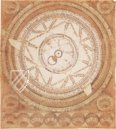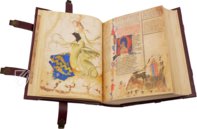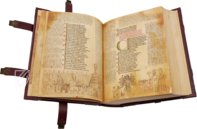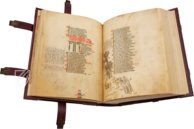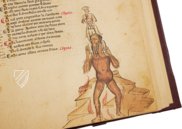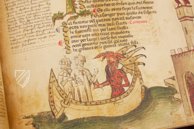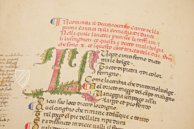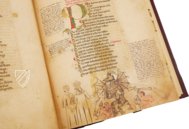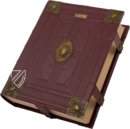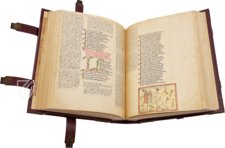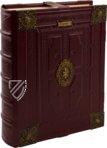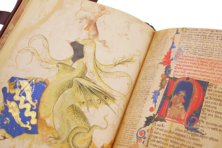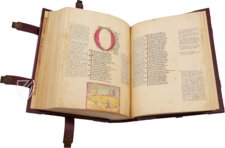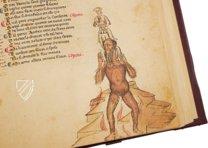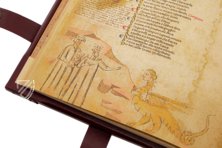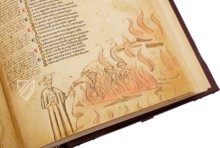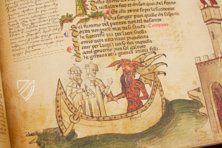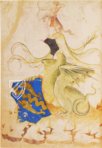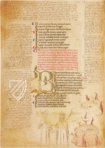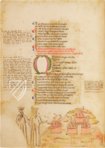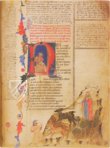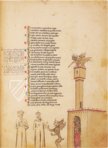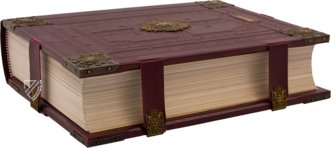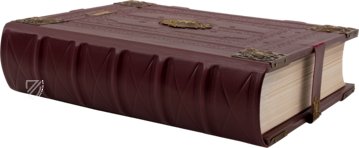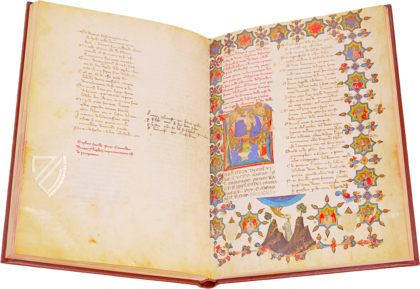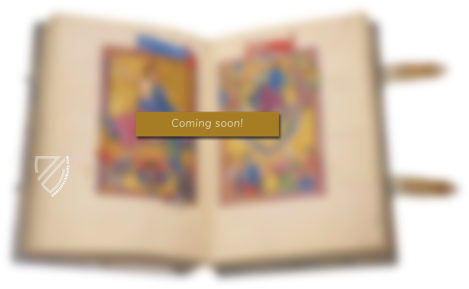Divine Comedy - Pluteo 40.7 Manuscript
(3,000€ - 7,000€)
With his Divine Comedy, Dante Alighieri (1265–1321) not only created his magnum opus ca. 1307, but also founded Italian literature. Today, countless editions of this masterpiece are in existence, including the splendid specimen at hand from the second half of the 14th century, which was once owned inter alia by Cosimo de' Medici, Grand Duke of Tuscany. The Gothic script is neatly written in a single, uniform column with red and blue initials and is often accompanied by marginal notes in miniscule handwriting that were added at a later date. Expressive miniatures with a wonderful narrative quality illustrate the events of Dante’s journey through Hell, Purgatory, and Heaven.
Divine Comedy - Pluteo 40.7 Manuscript
Few authors have been as influential as Dante Alighieri (1265–1321), author of the famous Divine Comedy. This work counts among a group of ca. 15 large format Dante manuscripts and was originally written with Gothic script by a skilled scribe in the 1360’s. 130+ miniatures created by four artists adorn the text, which is written in one column and designed with large historiated initials and bas-de-page miniatures at the beginning of each canto. The commentary and notes in the margins of the text were added by an unknown Florentine merchant for the purpose of explaining the numerous hidden meanings and references to various events and characters contained in the poem. Written around the end of the 14th century, the small, neatly written notes used a system of letters and numbers to link the original text with his commentary. After passing through the hands of various unknown owners, the manuscript eventually came into the possession of the Grand Duke of Tuscany, Cosimo de' Medici (1519–1574).
The Divine Dante
Dante's Commedia is the first and greatest foundation of Italian national identity and literary civilization: not only for the immeasurable historical, linguistic, literary, and cultural importance of the work, one of the pillars – along with the Bible, the Homeric poems, the Aeneid, Shakespeare's tragedies, Don Quixote, and Faust – of the European and Western canon. The poem constitutes one of those rare works whose high level of inspiration and exceptional linguistic, literary, and structural complexity have not prevented it from becoming truly popular. It is simultaneously a difficult, profound and very high work of art that is also understood and loved by all. Much like us, Dante also lived in a historical period marked by profound and radical transformations at the sunset of the Middle Ages. In the total image of the world evoked in the three canticles of the poem, he was able to create a summa of medieval civilization in all its aspects, recreating it in renewed and original forms and thus knowing how to transmit its most vital elements to the culture of the following centuries.
The Work of Four Artists
Although it appears that one hand transcribed Dante’s original text, the décor was the work of at least four artists. The Inferno was illustrated by two miniaturists who worked at the time the codex was prepared, decorating it with lively, realistic figures with strong emotional intensity. On the one hand, they convey Dante's inventive power, while on the other they reflect the typically medieval obsession with the evil and diabolical, expressed by the infernal demons scattered throughout the pages. The illustrations of Purgatory and Paradise, on the other hand, were completed by two skilled illustrators who, towards the end of the 15th century, continued the work of the illuminators by decorating the last two canticles with a series of watercolor vignettes, characterized by a graceful stroke, soft colors, and images of strong didactic evidence.
Mysterious Journey to the Laurentian Library
The original owner is unknown, but the manuscript was written on paper instead of parchment, pointing to a patron who had a budget. Sometime in the next two centuries, a parchment sheet was inserted into the beginning of the book opposite the first page of text with the coat of arms of a yet-unidentified family. It consists of two golden dolphins separated by a wavy band of gold on a field of blue and is held up by a green dragon whose face is hidden by a black helmet. On top of its head, a centaur stands on its back legs with its bow drawn. After the manuscript was acquired by Cosimo de’ Medici, he had it rebound with embossed red leather over wooden boards with a central medallion and metal corner-pieces bearing the Medici arms surmounted by the grand-ducal crown and flanked by the initials C and M. This was done in preparation for the opening of the Laurentian Library to the public on June 11, 1571 – the Grand Duke's birthday.
Codicology
- Alternative Titles
- Dante Alighieri. Commedia Ms. Pluteo 40.7
Dante Alighieri - Göttliche Komödie Ms. Pluteo 40.7
Divine Comedy Ms. Pluteo 40.7 - Type
- Manuscript on paper
- Size / Format
- 478 pages / 39.0 × 29.0 cm
- Origin
- Italy
- Date
- Second half of the 14th century
- Epochs
- Style
- Genre
- Language
- Script
- Gothic Textura Mercantesca
Divine Comedy - Pluteo 40.7 Manuscript
Author Portrait
On the opening page of text, Dante appears in a large red “N” initial with a blue background with his book lying open on his lap. Despite his rich garments, including stylish red boots, Dante holds his head and visibly sags because he is weary of the mortal world and is about to undergo his journey through the afterlife. The small, tightly written notes in the margin contrast with the scribe’s clearly written text, the opening lines of which are written in expensive red ink.
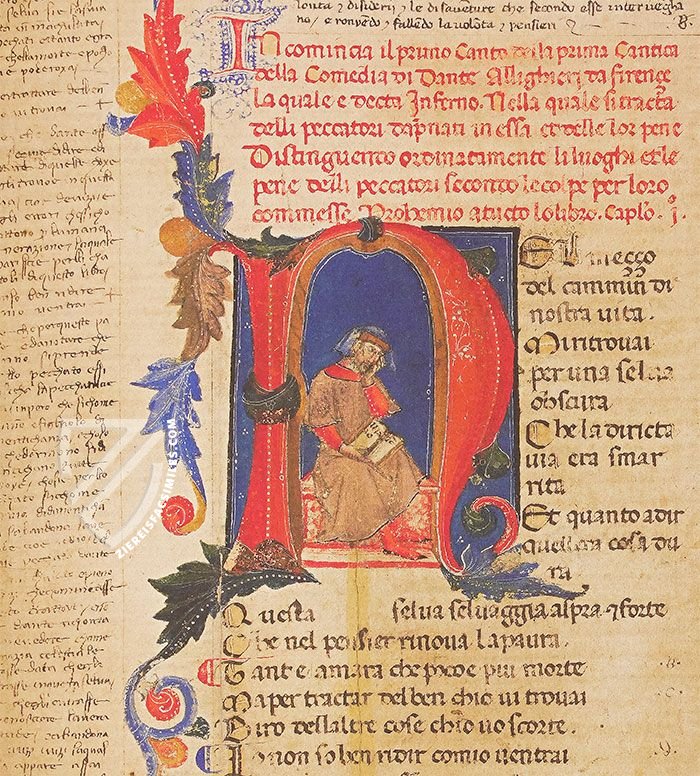
Divine Comedy - Pluteo 40.7 Manuscript
Virgil Confronts Demons before the City Gate of Dis
This page’s bas-de-page illustrates the second fundamental episode of the canto, that of the tense confrontation between Virgil (bearded and labelled with a “V”) and the demon in front of the gate of Dis. The animated gesture that accompanies Virgil's dialogue with one of the demons is probably intended to express the moment in which Virgil signals that he wants to speak with them.
Take note of Virgil’s lowered index finger turned towards the demon, a sign of confidential exchange, accompanied by the gesture of the other raised open hand, a typical gesture of dialogue. A group of demons witness this exchange from one of the city’s towers and one of them points down towards the two newcomers while another demon guards the open gate.

#1 Dante Alighieri. Commedia Ms. Pluteo 40.7
Language: Italian
(3,000€ - 7,000€)
- Treatises / Secular Books
- Apocalypses / Beatus
- Astronomy / Astrology
- Bestiaries
- Bibles / Gospels
- Chronicles / History / Law
- Geography / Maps
- Saints' Lives
- Islam / Oriental
- Judaism / Hebrew
- Single Leaf Collections
- Leonardo da Vinci
- Literature / Poetry
- Liturgical Manuscripts
- Medicine / Botany / Alchemy
- Music
- Mythology / Prophecies
- Psalters
- Other Religious Books
- Games / Hunting
- Private Devotion Books
- Other Genres
- Afghanistan
- Armenia
- Austria
- Belgium
- Belize
- Bosnia and Herzegovina
- China
- Colombia
- Costa Rica
- Croatia
- Cyprus
- Czech Republic
- Denmark
- Egypt
- El Salvador
- Ethiopia
- France
- Germany
- Greece
- Guatemala
- Honduras
- Hungary
- India
- Iran
- Iraq
- Israel
- Italy
- Japan
- Jordan
- Kazakhstan
- Kyrgyzstan
- Lebanon
- Liechtenstein
- Luxembourg
- Mexico
- Morocco
- Netherlands
- Palestine
- Panama
- Peru
- Poland
- Portugal
- Romania
- Russia
- Serbia
- Spain
- Sri Lanka
- Sweden
- Switzerland
- Syria
- Tajikistan
- Turkey
- Turkmenistan
- Ukraine
- United Kingdom
- United States
- Uzbekistan
- Vatican City
- A. Oosthoek, van Holkema & Warendorf
- Aboca Museum
- Ajuntament de Valencia
- Akademie Verlag
- Akademische Druck- u. Verlagsanstalt (ADEVA)
- Aldo Ausilio Editore - Bottega d’Erasmo
- Alecto Historical Editions
- Alkuin Verlag
- Almqvist & Wiksell
- Amilcare Pizzi
- Andreas & Andreas Verlagsbuchhandlung
- Archa 90
- Archiv Verlag
- Archivi Edizioni
- Arnold Verlag
- ARS
- Ars Magna
- ArtCodex
- AyN Ediciones
- Azimuth Editions
- Badenia Verlag
- Bärenreiter-Verlag
- Belser Verlag
- Belser Verlag / WK Wertkontor
- Benziger Verlag
- Bernardinum Wydawnictwo
- BiblioGemma
- Biblioteca Apostolica Vaticana (Vaticanstadt, Vaticanstadt)
- Bibliotheca Palatina Faksimile Verlag
- Bibliotheca Rara
- Boydell & Brewer
- Bramante Edizioni
- Bredius Genootschap
- Brepols Publishers
- British Library
- C. Weckesser
- Caixa Catalunya
- Canesi
- CAPSA, Ars Scriptoria
- Caratzas Brothers, Publishers
- Carus Verlag
- Casamassima Libri
- Centrum Cartographie Verlag GmbH
- Chavane Verlag
- Christian Brandstätter Verlag
- Circulo Cientifico
- Club Bibliófilo Versol
- Club du Livre
- CM Editores
- Collegium Graphicum
- Collezione Apocrifa Da Vinci
- Comissão Nacional para as Comemorações dos Descobrimentos Portugueses
- Coron Verlag
- Corvina
- CTHS
- D. S. Brewer
- Damon
- De Agostini/UTET
- De Nederlandsche Boekhandel
- De Schutter
- Deuschle & Stemmle
- Deutscher Verlag für Kunstwissenschaft
- DIAMM
- Droz
- E. Schreiber Graphische Kunstanstalten
- Ediciones Boreal
- Ediciones Grial
- Ediclube
- Edições Inapa
- Edilan
- Editalia
- Edition Deuschle
- Edition Georg Popp
- Edition Leipzig
- Edition Libri Illustri
- Editiones Reales Sitios S. L.
- Éditions de l'Oiseau Lyre
- Editions Medicina Rara
- Editorial Casariego
- Editorial Mintzoa
- Editrice Antenore
- Editrice Velar
- Edizioni Edison
- Egeria, S.L.
- Eikon Editores
- Electa
- Emery Walker Limited
- Enciclopèdia Catalana
- Eos-Verlag
- Ephesus Publishing
- Ernst Battenberg
- Eugrammia Press
- Extraordinary Editions
- Fackelverlag
- Facsimila Art & Edition
- Facsimile Editions Ltd.
- Facsimilia Art & Edition Ebert KG
- Faksimile Verlag
- Feuermann Verlag
- Folger Shakespeare Library
- Franco Cosimo Panini Editore
- Friedrich Wittig Verlag
- Fundación Hullera Vasco-Leonesa
- G. Braziller
- Gabriele Mazzotta Editore
- Gebr. Mann Verlag
- Gesellschaft für graphische Industrie
- Getty Research Institute
- Giovanni Domenico de Rossi
- Giunti Editore
- Graffiti
- Grafica European Center of Fine Arts
- Guido Pressler
- Guillermo Blazquez
- Gustav Kiepenheuer
- H. N. Abrams
- Harrassowitz
- Harvard University Press
- Helikon
- Hendrickson Publishers
- Henning Oppermann
- Herder Verlag
- Hes & De Graaf Publishers
- Hoepli
- Holbein-Verlag
- Houghton Library
- Hugo Schmidt Verlag
- Idion Verlag
- Il Bulino, edizioni d'arte
- ILte
- Imago
- Insel Verlag
- Insel-Verlag Anton Kippenberger
- Instituto de Estudios Altoaragoneses
- Instituto Nacional de Antropología e Historia
- Istituto dell'Enciclopedia Italiana - Treccani
- Istituto Ellenico di Studi Bizantini e Postbizantini
- Istituto Geografico De Agostini
- Istituto Poligrafico e Zecca dello Stato
- Italarte Art Establishments
- Jan Thorbecke Verlag
- Johnson Reprint Corporation
- Josef Stocker
- Josef Stocker-Schmid
- Jugoslavija
- Karl W. Hiersemann
- Kasper Straube
- Kaydeda Ediciones
- Kindler Verlag / Coron Verlag
- Kodansha International Ltd.
- Konrad Kölbl Verlag
- Kurt Wolff Verlag
- La Liberia dello Stato
- La Linea Editrice
- La Meta Editore
- Lambert Schneider
- Landeskreditbank Baden-Württemberg
- Leo S. Olschki
- Les Incunables
- Liber Artis
- Library of Congress
- Libreria Musicale Italiana
- Lichtdruck
- Lito Immagine Editore
- Lumen Artis
- Lund Humphries
- M. Moleiro Editor
- Maison des Sciences de l'homme et de la société de Poitiers
- Manuscriptum
- Martinus Nijhoff
- Maruzen-Yushodo Co. Ltd.
- MASA
- Massada Publishers
- McGraw-Hill
- Metropolitan Museum of Art
- Militos
- Millennium Liber
- Müller & Schindler
- Nahar - Stavit
- Nahar and Steimatzky
- National Library of Wales
- Neri Pozza
- Nova Charta
- Oceanum Verlag
- Odeon
- Orbis Mediaevalis
- Orbis Pictus
- Österreichische Staatsdruckerei
- Oxford University Press
- Pageant Books
- Parzellers Buchverlag
- Patrimonio Ediciones
- Pattloch Verlag
- PIAF
- Pieper Verlag
- Plon-Nourrit et cie
- Poligrafiche Bolis
- Presses Universitaires de Strasbourg
- Prestel Verlag
- Princeton University Press
- Prisma Verlag
- Priuli & Verlucca, editori
- Pro Sport Verlag
- Propyläen Verlag
- Pytheas Books
- Quaternio Verlag Luzern
- Reales Sitios
- Recht-Verlag
- Reichert Verlag
- Reichsdruckerei
- Reprint Verlag
- Riehn & Reusch
- Roberto Vattori Editore
- Rosenkilde and Bagger
- Roxburghe Club
- Salerno Editrice
- Saltellus Press
- Sandoz
- Sarajevo Svjetlost
- Schöck ArtPrint Kft.
- Schulsinger Brothers
- Scolar Press
- Scrinium
- Scripta Maneant
- Scriptorium
- Shazar
- Siloé, arte y bibliofilia
- SISMEL - Edizioni del Galluzzo
- Sociedad Mexicana de Antropología
- Société des Bibliophiles & Iconophiles de Belgique
- Soncin Publishing
- Sorli Ediciones
- Stainer and Bell
- Studer
- Styria Verlag
- Sumptibus Pragopress
- Szegedi Tudomànyegyetem
- Taberna Libraria
- Tarshish Books
- Taschen
- Tempus Libri
- Testimonio Compañía Editorial
- Thames and Hudson
- The Clear Vue Publishing Partnership Limited
- The Facsimile Codex
- The Folio Society
- The Marquess of Normanby
- The Richard III and Yorkist History Trust
- Tip.Le.Co
- TouchArt
- TREC Publishing House
- TRI Publishing Co.
- Trident Editore
- Tuliba Collection
- Typis Regiae Officinae Polygraphicae
- Union Verlag Berlin
- Universidad de Granada
- University of California Press
- University of Chicago Press
- Urs Graf
- Vallecchi
- Van Wijnen
- VCH, Acta Humaniora
- VDI Verlag
- VEB Deutscher Verlag für Musik
- Verlag Anton Pustet / Andreas Verlag
- Verlag Bibliophile Drucke Josef Stocker
- Verlag der Münchner Drucke
- Verlag für Regionalgeschichte
- Verlag Styria
- Vicent Garcia Editores
- W. Turnowski Ltd.
- W. Turnowsky
- Waanders Printers
- Wiener Mechitharisten-Congregation (Wien, Österreich)
- Wissenschaftliche Buchgesellschaft
- Wissenschaftliche Verlagsgesellschaft
- Wydawnictwo Dolnoslaskie
- Xuntanza Editorial
- Zakład Narodowy
- Zollikofer AG







